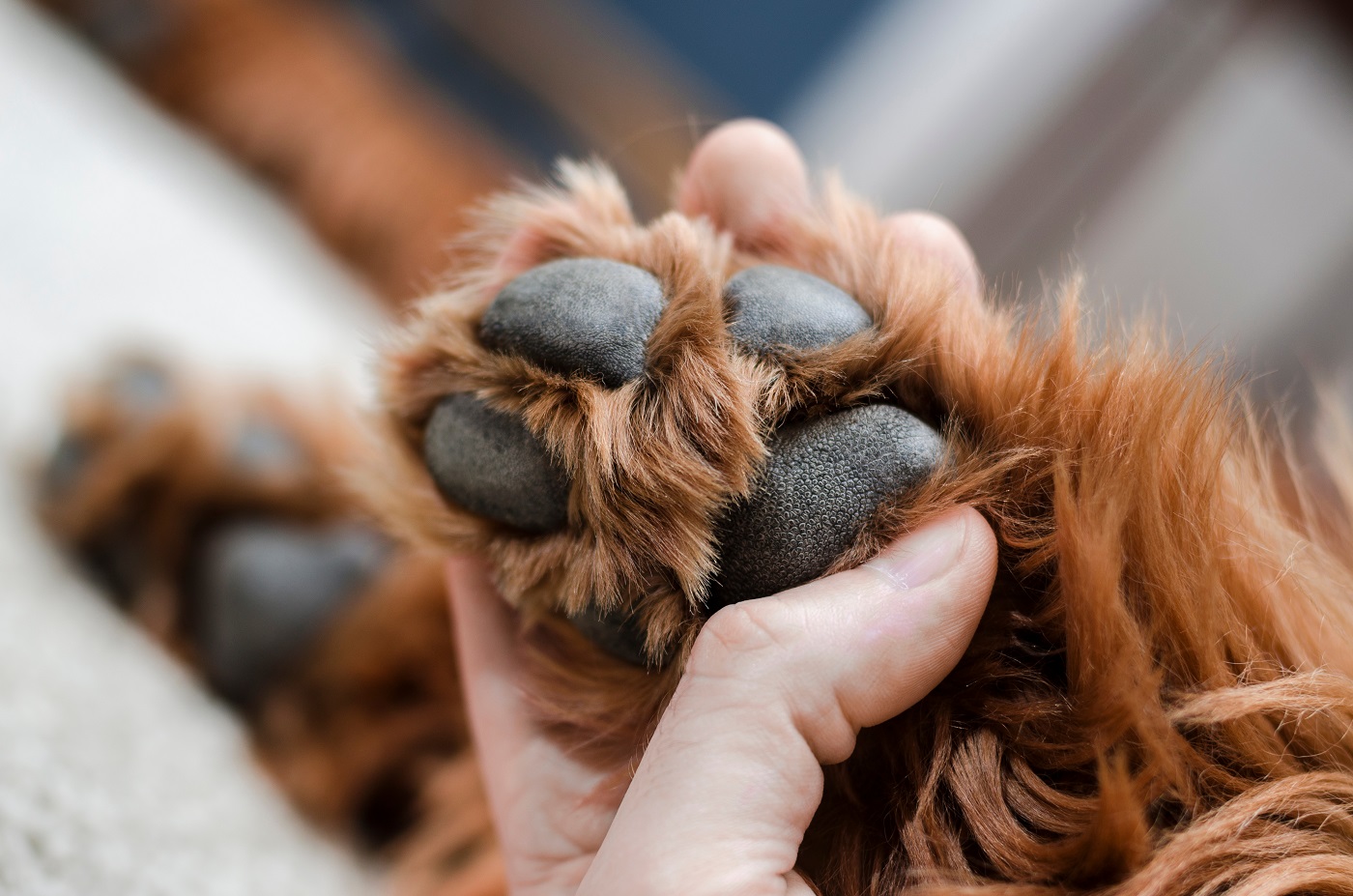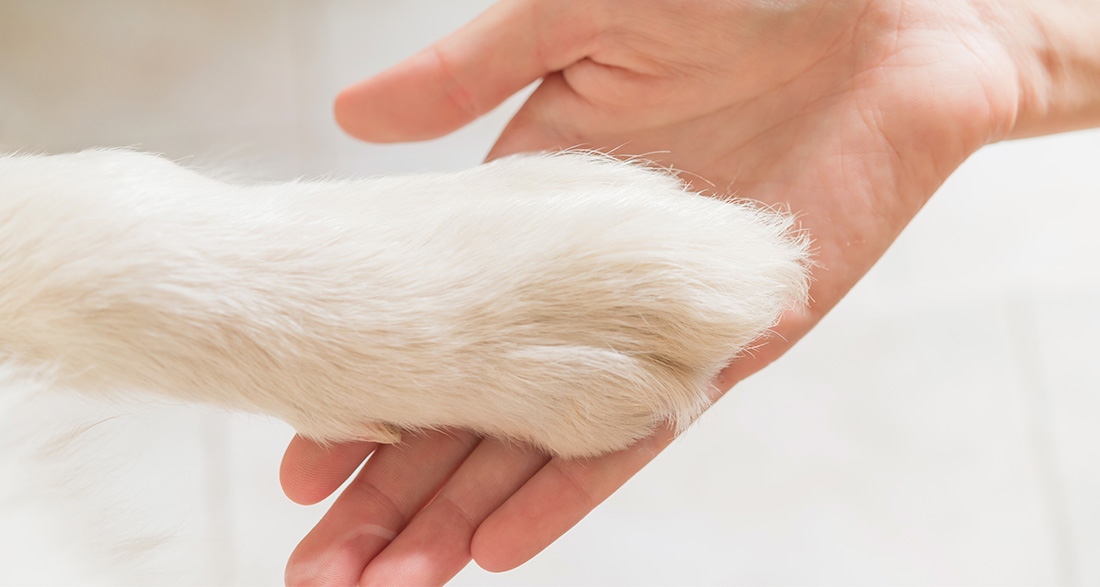The entire weight of the dog rests on its paws, which are heavily used every day. Therefore, keeping your dog’s paws healthy is crucial. But how do you recognize healthy dog paws, and what is the proper way to care for them? Find all the answers in this article.
Structure: How is the Dog Paw Constructed?
Many dog owners may focus more on their dog’s shiny fur and cute gaze than on their paws. However, your dog’s paws are of great importance to him—after all, they are his foundation.
To recognize pathological changes and potential suffering in your dog early on, it is crucial to understand the structure of healthy dog paws:
Bones for Support
The bones of the dog’s paws provide support and structure. The front paws consist of five different-length digits (manus digits), which are further divided into additional bones (from top to bottom). The first digit is shortened, while the third and fourth digits are the longest.
The hind paws have a similar structure to the front paws but only have four digits. Therefore, they are slightly smaller than the front paws.
Joints and Muscles for Movement
Many small joints and muscles on all four paws are responsible for your dog’s ability to move its paws—whether stretching or bending. Injuries to muscles, tendons, or joints can restrict the movement of the dog’s paws.
Pads for Cushioning
Each paw has various pads (tori) that you can recognize as hairless skin areas on the underside:
Front paw: five digital pads, a metacarpal pad, and a carpal pad Hind paw: four digital pads, a metacarpal pad, and a carpal pad Since the pads consist of a thick cushion of subcutaneous tissue, fat, and muscles, they protect the dog’s paws when walking on uneven terrain.
Claws as Tools
The claws embedded in the claw bed each enclose a blood vessel. If you cut the claws too short, you can open these vessels and cause severe bleeding.
Dog as a Digitigrade
While humans, known as plantigrades, place their entire foot on the ground when walking—everything between the toe and heel—other animals like dogs, known as digitigrades, walk only on their toes. This characteristic is why they are called “toe-walkers” or digitigrades. The advantage is that dogs can run much faster than humans.

Function: What Makes a Dog Paw Special?
Although dogs cannot grasp objects with their paws like humans can with their thumbs, dog paws and human hands or feet are similar in their functions.
Dog paws contribute significantly to typical dog behaviors, such as fast running or stealthy stalking during hunting. Additionally, to protect joints and bones during movements, paws serve as essential shock absorbers.
Moreover, the paws have many small scent glands that your dog needs to spread its scent. In a way, the paws leave your dog’s individual business card—a unique scent mark.
Health: What Are Typical Paw Conditions?
While dog paws are quite robust and protected against many environmental influences due to their special structure, diseases and injuries can still occur. In addition to other diseases such as cancer (e.g., mast cell tumor), the following injuries are more common:
Injured Pads
The pads of dog paws endure a lot. While they can withstand various stresses, such as sharp glass shards or pointed nails, some challenges may be too much. The biggest threat to paw pads is injuries from foreign objects penetrating them.
Grass awns, especially, can be unpleasant as they tend to settle in the toe spaces and gradually bore into the skin. To prevent this, examine your dog’s paws, especially after romping on summer meadows, for grass awns.
Injured Claws
Sometimes, during rough play at the dog park, your dog may tear a claw. Also, when walking on escalators or metal grates in the city, a dog’s claw can get stuck between the gaps, resulting in a torn claw when pulled out.
Claw injuries can cause heavy bleeding on one hand and quick infection on the other if pathogens from the environment enter the wound. Therefore, treat every injured claw promptly and have it examined by your veterinarian.
What to Do When a Dog Paw Is Injured?
Since your dog may experience severe pain with a paw injury, make sure he doesn’t bite you during initial care. Therefore, it is crucial not to act alone and, ideally, use a muzzle or a mouth restraint.
Find out the steps for the initial treatment of a paw injury in this article:
Dog Paw Injury
How to Provide First Aid?
To avoid bacterial infections, always show the wound to your vet after initial care. Your vet can carefully treat deeper foreign objects or cuts.
How Does an Inflamed Dog Paw Look?
Healthy dog paws are generally soft and smooth. You can identify an initial inflammation if the paw is red and swollen. Affected dogs often lick the paw more, worsening the inflammation. Also, the paw becomes noticeably warm, and pus-filled ulcers (abscesses) may form.
Proper Paw Care for Dogs
As dog paws are crucial for your dog’s health, regular care is essential. Check and clean the paws regularly, especially after walks. Trim the claws with a claw clipper or file when possible.
Caution in Cold and Snow
If your dog has particularly long hair on the paws, you can trim it gently between the toes, especially in winter. This helps prevent the hair from clumping with snow.
Paws stressed by cold weather will also appreciate occasional application of a gentle paw balm on the dry pads. Don’t forget the spaces between the toes, and avoid applying too much of a good thing.


